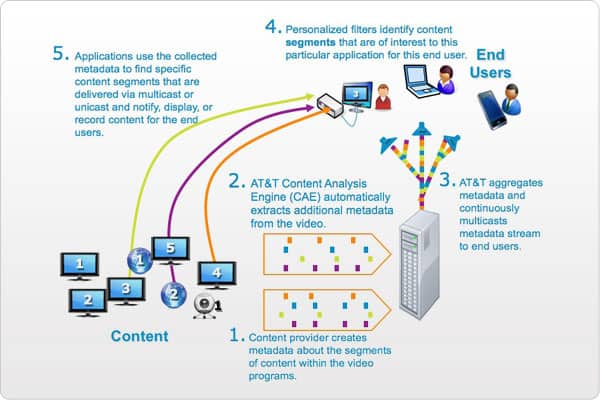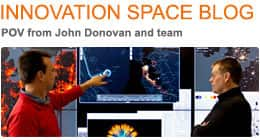Overview
As the volume of TV and entertainment content increases, consumers are spending more time channel surfing for programs and leaving less time to enjoy the shows they actually want to watch. TV guides list hundreds of options to help with navigation, but having more choices can be overwhelming for the TV watcher interested in getting to a specific program or sporting event quickly. Following more than a decade of research around automatic media processing technologies, AT&T has developed a new way of consuming content that will enable access to personalized programming at home or on a device based on users' preferences.
How did the Idea Hatch?
The idea started from a simple consideration: how much easier would it be for users to access content if they didn't have to look for it, but a system would provide them with personalized information about what is available? Starting from this concept, AT&T Labs researchers developed the idea for Content Augmenting Media (CAM). They envisioned a scenario where media and service providers could provide and distribute detailed descriptions of content to users and consumers could match their entertainment preferences based on the received descriptions in real-time. Such descriptions are much more powerful than the traditional Electronic Program Guide (EPG) as they describe the content in greater detail and keep up with content changes in real time during the program. The proposal was submitted through the TIP process and was quickly transferred to AT&T's Fast Track for prototype development.
About the Project
CAM brings users the content they are interested in watching on TV while minimizing their time searching for it. Combining AT&T's MIRACLE back-end technology, CAM extracts TV content from providers and delivers real-time notifications to consumers when any channel matches up to the profile of keywords they've created. Keywords can include names of people, locations or other popular topics, and profiles are saved for editing at any time from the user's mobile device or tablet. CAM also uses AT&T's Speech to Text to simultaneously provide other suggested programming based on keywords while the users are watching TV. The concept has been developed as a collaboration of AT&T Labs Research and AT&T and implemented with the involvement of Net-Scale third party development.
The Future
- Notion of channel searching is cut out almost completely. CAM delivers personalized content every time a user sits down to watch TV. Consumers can watch one program and receive suggestions about others following the same trend.
- Dynamic profile. Users have the ability to change keywords and preferences anytime through their mobile devices, ensuring their profile is always up-to-date.
- Potentially can drive advertisements and social networking. By gaining knowledge of personal entertainment preferences, CAM has the ability to provide not only suggested content, but target merchandising and link consumers with like-minded interests.
About the Researcher
Andrea Basso has been a member of AT&T Labs Research for six years. He is the innovative champion behind many of AT&T's media processing technologies including MIRACLE and CONSENT. He is also involved in the development of standards in several international bodies including IETF, ISO/MPEG, ITU-T and IMTC. Dr. Basso is author or co-author of more than 60 publications and three books in the area of video processing and networked multimedia services and holds 21 granted patents. In previous roles, Basso served as the chief architect at NMS Communications and was a research associate at Stanford University.


